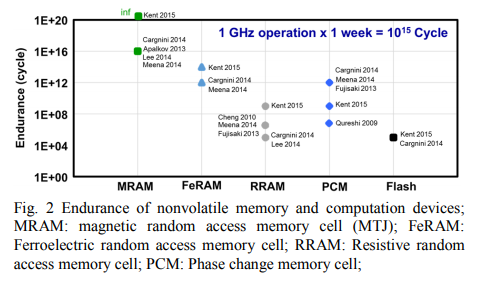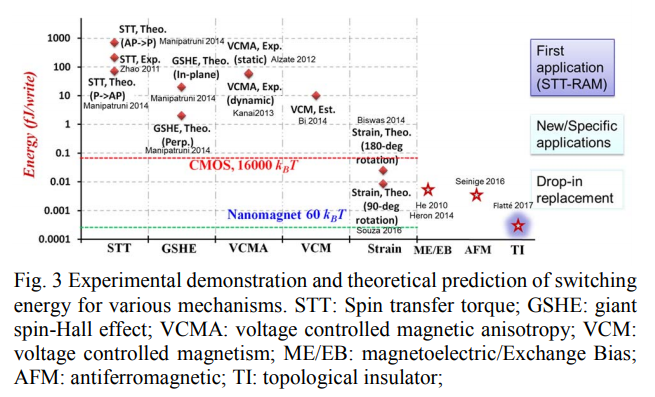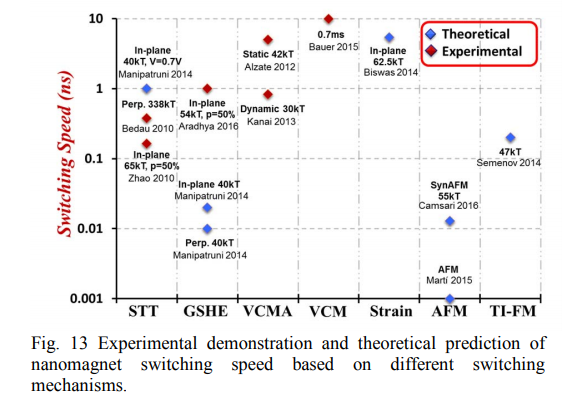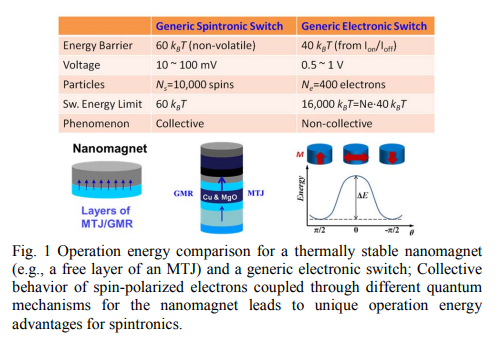Basic physics parameter for switching&dissipation
Defined in the paper (Manipatruni-Nikonov), the figure of merit λ for any tunneling junction/CMOS transistor/switch/MtJ
λ=EdissipationEbarrier
where Edissipation≈Eswitching is the dissipation energy, which is also approximately equal switching energy.
- notice that Ebarrier is always around 1−1.5eV, so λ is really determined by collective versus single-electron physics mechanism and the size of the cell (anything else basic?)
In another paper (Wang - Koester) , the authors argue that λ≈1 is achievable. In particular, GSHE looks better than stt-MRAM. AFM and TI (at room temperature) can make significant breakthroughs, especially when made commercial (no sooner than 5 years?).
for the electronic-charge switch, λ is of order Ne∼400.
for stt-MRAM, λstt−mram>1000 is indicated, while in 2014 (from Wang-Koester) we can see λstt−mram≈4∗105. This means that basic STT-MRAM is not particularly energy-efficient. From the table on IMComputing page., the review in 2019 we can see λstt−mram≈104.
the summary - the smaller the dimensionless parameter λ is the better. This parameter must be larger than 1 for any classical switching. Different switching devices need to optimize this parameter, both CMOS and stt-mram are not at the possible, but very difficul physics-allowed, limit of this parameter.
key figures from the paper (Wang - Koester)
- excellent endurance of stt-MRAM (as well as commercial development)
stt-mram has the best endurance among emerging NVMs, still behind by 1-2 orders of magnitude from SRAM and DRAM, see IMComputing
- Switching energy per write operation for stt-MRAM is a severe limitation due to λstt−mram>1000
Write energy of stt-mram is about 2 orders of magnitude worse than for CMOS (1600 kT line). stt-mram does not have here advantage against charge-based DRAM and SRAM in spite of being “collective spintronic switch”. SRAM is about 2 orders better in write energy than stt-mram, as you can see from the picture above.
Topological Insulator and Sraintronics-based predicted to be very energy-efficient, but very far from being commercially ready (while in 2021y)
- the challenge of switching speed
distinguish between theoretical and realised versions
stt-mram is the best among experimentally shown to work.
stt- mram is slightly behind in write/read speed than SRAM (the fastest), but close (within 1 order of magnitude).
AFM might become really good both in the switching energy category and the switching speed!
- speed and energy efficiency are two main goals for computing (AI hardware), so far as cost, non-volatility, and endurance are satisfactory (from the point of view of business applications)
the picture below shows "the ideal collective spintronic switch"
The fundamental advantage of this approach over the semiconductor-based switch concept is its projected low operation energy.
Fig. 1 compares a generic spintronic switch and a generic electronic switch.
The picture might be misunderstood. stt-mram is NOT the “ideal collective spintronic switch”.



